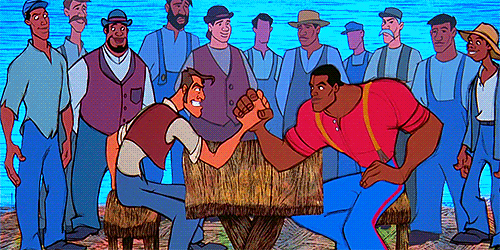The Disney image of history is, more often than not, fictionalized in order to produce a better movie plot. There are several examples of historical figures that were manipulated in to animal-befriending, stunningly beautiful, and missing at least one parent, prince or princess. Pocahontas is an example of a historical figure turned Disney princess with a fictionalized story with talking trees and in reality, helped the settlers a lot less than her Disney princess is portrayed to do.
John Henry’s legend was also modified for the Disney version. For those who may have never heard the legend, John Henry was imprisoned for a crime during the black code era. He was then a steel worker working on a railway that challenged a new machine that was supposedly faster than humans. Henry ultimately defeated the machine by completing more by the day’s end. Due to exhaustion, Henry died after beating the steel machine.
We know from historical context and from the accounts of what actually happened on the construction of the Chesapeake and Ohio railroad from 1870-1873, no white men worked on the railway. It was solely black men. In the Disney version, there are men of all different races working on the railroad. This is fictionalized, Henry, along with the other workers were leased from prisons to work for the railroad for cheap labor.
The classic folk song that has been covered by artists like Bruce Springsteen and Elvis Presley, was even changed for the Disney story. There are over four hundred versions of the song, however, they are all held together by the common themes in the song that highlight John Henry’s life like his death and being buried at the White House[1]. Arguably the most famous part about Henry’s legend, the song, could not make the cut for its original content in the Disney cartoon.
The “promised land” is the land that is granted to the individuals in the Disney short film for the workers constructing the railroad. If they finish the project, they will receive this land in exchange. In reality, there was no promised land. With that, there was no bet with the man operating the machine that John had to beat in order to get the land that they were promised in the first place. And after his passing, it was not like in the Disney short that Henry saved the day for all those who outlived him and were able to live on the land and remember the man who made it all possible.
The Disney character is also sketched out to be dramatically large, with a ridiculously unrealistic shoulder to waist ratio. His brawn figure is also falsified from the real recorded prison records of John Henry. The real John Henry was actually only 5’1″[2]. This makes it highly unlikely that he looked at all like the Disney version that makes him look superhuman with god-like strength. As exemplified below when he arm wrestles two other men with ease.

The Disney story makes John Henry as a slave. His steel hammer is even made out of the chains that were used during his enslavement and given as a wedding gift by his wife, Polly Ann. This is completely false. John Henry was not born a free man, but he was imprisoned after being freed from slavery.
What the Disney movie did get right, however, was the death of John Henry. He literally worked himself to death in pursuit of defeating the machine. Although John Henry is the legend that lives, there were hundreds of men that died doing the same thing that he did. Unlike the Disney short however, legend is that he was buried at the White House, a nearby penitentiary. John Henry lives on, however, through all of his reproductions in movies, song, and books.
[1] Nelson, Scott, Steel Drivin’ Man: John Henry, (Chicago: Oxford University Press, 2006), 55
[1] Ibid, 65


 With that being said, I’ll continue to give thousands of dollars to a Mouse to take him on vacation to Disney World after I put the monthly college contributions in the bank AND I’ll continue to let him watch movies where cats dance across pianos and dogs share pasta because I know he’s smart enough to ask me a question if he has one and I’ll take the responsibility of answering it, not leaving it to Disney.
With that being said, I’ll continue to give thousands of dollars to a Mouse to take him on vacation to Disney World after I put the monthly college contributions in the bank AND I’ll continue to let him watch movies where cats dance across pianos and dogs share pasta because I know he’s smart enough to ask me a question if he has one and I’ll take the responsibility of answering it, not leaving it to Disney.